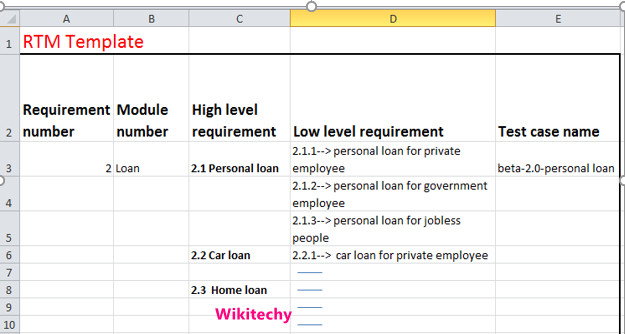Traceability Matrix - Software Testing Tutorial
Traceability Matrix
- A document that describes the technical requirements for a given test scenario and its current state is known as Traceability Matrix.
- Level of testing that is done for a given product can be understood by this document.
- Test cases that were defined for any requirement uses traceability process.
- Table type document which is used to trace requirements in development of software applications is called as Traceability Matrix.
- It can be used for both forward (from Requirements to Design or Coding) and backward (from Coding to Requirements) tracing.
- It is also known as Requirement Tracability Matrix(RTM) or Cross Referenece Matrix(CRM).
- Before the test execution process, this matrix is prepared to make sure that every requirement is covered in the form of Test case so we dont miss out on testing.
- For the respective assigned test cases all the requirements will be mapped with the RTM document to ensure that all the test cases for each condition.
- RTM are prepared for their respective assign modules and will be sent to the test lead.
- Repository will be checked by the test lead to check whether the test case is there or not and will consolidate and prepare one necessary RTM Document.
- This document is designed to make sure that each requirement has a test case, and the test case is written based on business needs, which are given by the client.
- If any requirements are missing, this can be performed with the help of test case.
- If the test case is not written for a particular need, the specific requirement is not tested because it may have some bugs.
- The traceability is written to make sure that the entire requirement is covered.
- Traceability matrix is like a worksheet document which contains table, but there are also many user defined templates.
- Each requirement in the traceability matrix is connected with its respective test case so that tests can be carried out sequentially according to specific requirements.
- To avoid missing out on any test case for requirement we have to get approval for RTM and before execution of the test case.
- RTM is not written during the testing because it can be incomplete, and after writing the test case, we dont go here because test case can be rejected.
- This document ensures that atleast one test case is written for each requirement, whereas it does not tell about all the possible test cases that can be written for a particular requirement.
- RTM document ensures that at least there is one test case written in each requirement, whereas it does not talk about all possible test cases written for the particular requirement.
RTM Template
Below is the sample template of requirement traceability matrix (RTM):

Example of RTM template

Goals of Traceability Matrix
- Documents that are developed during various phases of SDLC can be traced using traceability matrix.
- Is the software completly meeting the customer requirements can ensured using this document.
- Bugs root cause can be detected using this document.
Types of Traceability Test Matrix
- The traceability matrix can be classified into three different types which are as follows:
- Forward traceability
- Backward or reverse traceability
- Bi-directional traceability
Forward traceability
- It ensures that every business needs or requirement are executed correctly in the application and also tested rigorusly.
- This can be used to check if the product developments are going in the right direction.
- In this, requirements are mapped into the forward direction to the test cases.
Backward or reverse traceability
- This is used to check if we are not increasing the space of the product by enhancing the design elements, code, and test other things that are not given in the business needs.
- It is used to check if the existing project remains in the correct direction.
- Here requirements are mapped into backward direction to the test cases.
Bi-directional traceability
- We can use this matrix to check if all the business needs are executed in the test case.
- It is a combination of both forwarding and backward traceability matrix.
- Modifications in the requirements which occurs due to bugs in the application can be evaluated using this matrix type.
Advantage of RTM
- Test execution status and bugs executed status based on requirements can be achieved using this matrix.
- Missing requirements or conflicts in the documents can be shown by this matrix.
- By ensuring complete test coverage all modules can be tested using this matrix.
- It will also consider the efforts of the testing teamwork towards reworking or reconsidering on the test cases.
Click Here to download the Requirement Matrix Template
